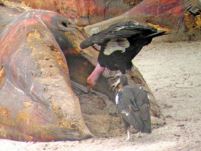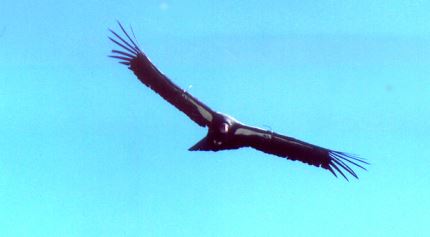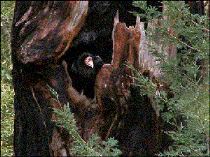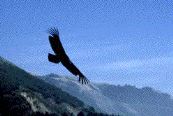|
Condors are nesting in coastal redwood Northern California has first sighting in more than century Carl T. Hall, Chronicle Staff Writer A pair of captive-bred California condors has established a nest and appears to be nursing an egg in a Big Sur redwood tree — Northern California’s first documented condor nesting site in 101 years. Biologists working to rescue the giant condor from threat of extinction used radio telemetry, satellite signals and a morning of bushwhacking through poison oak and stinging nettles to track the banded birds to a remote coastal canyon in Monterey County. As far as anyone knows, it’s the first time condors have been found nesting anywhere in a coastal redwood, rather than in the giant sequoias or cliffside rock crevasses they typically choose. The last known condor nest in Monterey County, or anywhere else in Northern California, was recorded on April 12, 1905, when collectors gathered an egg for the Western Foundation for Vertebrate Zoology. This week’s find establishes a new beachhead for California’s famed condor-recovery program, still struggling to overcome a long list of challenges, including heavy fatalities from such hazards as lead poisoning, attributed to consumption of ammunition when the carrion-eating birds clean up after hunters. At last count 271 condors are being observed in the wild, mostly in Southern and Central California, and including 57 in Arizona. The newfound nest is on private property, 40 feet above ground in the hollow of a damaged old redwood. Kelly Sorenson, executive director of the Ventana Wildlife Society, a Salinas group overseeing the Big Sur condor project, said the nest is within easy flying range of the birds’ release point into the wilds of Big Sur. The precise location is being held secret. A 27-year-old field biologist, Joseph Brandt, set out to find the nest before dawn Monday, after three days of tracking. He had to scramble down a steep hillside to reach the birds’ chosen redwood grove. From the hillside, he had seen what appeared to be the most likely tree, bigger than the others, its top missing. He circled around until he could find a vantage point a safe distance away. There, with his camera and binoculars, he waited. Brandt was equipped for an overnight stay in the woods, but before lunch, he saw the male condor — a 9-year-old born at the Los Angeles Zoo and released into the wild in 1997 — fly out of the nest, light on a nearby branch, then promptly return to the hollow. |
updates about Big Sur condors from the Big Sur Lodge
Condor nesting in Big
Sur Condor 167 peers out of the nest cavity of a giant Redwood tree. Condor 167 and his mate, 190, could be incubating an egg inside. This is the first condor nest in Monterey County in 101 years and the first documented nest in a redwood tree. |
|
Researchers spy condor
feeding Posted Thursday, May 4, 2006 The first recorded sighting of a California condor feasting on a dead beached whale in 200 years was made over the weekend on the Big Sur Coast. A California gray whale, stranded on the shore south of Point Sur, was seen from a helicopter and the sighting was reported to the state Department of Fish and Game, said Kelly Sorenson of the Ventana Wildlife Society.  Fish and Game officials were unable to reach the site because of tides, but members of the Ventana Wildlife Society on Sunday climbed down the cliffs to the beach, where senior wildlife biologist Joe Burnett took photos of the event. Clearly visible in his pictures is Condor No. 22, a 6-year-old female, Burnett said. The Ventana Wildlife Society has been releasing condors that were hatched in zoos and raised by humans into the wilds of Big Sur since 1996, and at Pinnacles National Monument since 2004. “The birds are becoming more and more independent,” Sorenson said. “They’re feeding and breeding on their own. It’s like bringing back prehistoric times. Seeing a condor feeding on a 40-foot beached gray whale in Big Sur conjures up a pretty incredible image.” Condor 22 is on the brink of breeding age, Burnett said. Since Sunday, the society has logged seven of the 25 Big Sur condors at the whale carcass. “We’ve always known and suspected the ocean would produce a food source for these birds,” he said. The first confirmation of that presumption came in 1999, when condors were found feeding on a dead sea lion, “another magical day.” A priest who sailed with Gaspar de Portola’s expedition along the California coast in 1602, Father Antonio de la Ascencion, reported seeing “large vultures” with an estimated wingspan of 10 to 12 feet feeding on a beached whale carcass, Burnett said. In 1805, the Lewis and Clark expedition came upon a condor doing the same at the mouth of the Columbia River. They described “a remarkably large buzzard, feeding on the remains of a whale,” Burnett said, and one of them shot the condor as a specimen for the expedition’s scientific collection. The whale feeding puts the birds “one step closer to being self-sustaining,” he said, adding that he and other society biologists still supplement-feed the young birds after release. The first wild condor chick to take flight in California in 22 years left its nest in Ventura County in October 2004. That bird was hatched the previous April near Hopper Mountain National Wildlife Refuge and the mother had been released in Big Sur by the Ventana Wildlife Society. Most condors continue to be bred in
captivity. There are an estimated 276 living. Some released
birds died from lead poisoning after ingesting bullets or
shotgun pellets while eating the carcasses of game shot by
hunters. Other birds were electrocuted after landing on
high-tension power lines. The society, the only nonprofit organization in California releasing condors into the wild, is a member of the California Condor Recovery Program, which consists of government and nongovernment agencies, including the U.S. Fish and Wildlife Service, U.S. Forest Service, San Diego Wild Animal Park, the Los Angeles Zoo and the state Department of Fish and Game. About 50 condors, the largest land birds in North America, have been turned loose during annual releases in Big Sur. In October, the carcass of a male, Condor No. 164, was discovered in Ventura County, the eighth released by the society to have died. That bird’s death was a setback for the society’s goal of establishing breeding pairs in the wild, Sorenson said, because the condor had reached breeding age and its aggressive nature made it a natural candidate to be a breeder. There are 38 condors in the wild in Central California, Sorenson said, and the society has set a goal of establishing 150 in the wild with 15 breeding pairs. In March, the first nesting pair seen in Monterey County in more than a century was sighted in a hollow redwood tree in Big Sur and photographed by biologist Joseph Brandt, Burnett said. A second nesting pair has been found nearby since. “It shows things are working,” Burnett said. “Things are coming together.“ |


